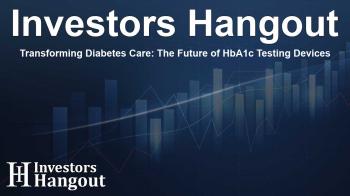Transforming Diabetes Care: The Future of HbA1c Testing Devices

Overview of the Hemoglobin A1c Testing Devices Market
The Hemoglobin A1c Testing Devices Market is undergoing a major transformation, as it is projected to reach a remarkable value of over US$ 3.3 billion by 2034. This anticipated growth, representing a compound annual growth rate (CAGR) of 7.7% from the previous years, is fueled by the increasing prevalence of diabetes and advancements in technology aimed at improving diabetes management.
Rising Demand for HbA1c Testing Solutions
The surge in demand for HbA1c testing devices can be attributed to the alarming rise in diabetes cases worldwide. The necessity for early detection and efficient management of diabetes has led healthcare professionals and pharmaceutical companies to heavily invest in diagnostic solutions. These investments are aimed at promoting early intervention strategies and enhancing the overall quality of care for individuals managing diabetes.
Advancements in Diagnostic Technology
Continuous improvements in diagnostic technology are making a significant impact on the market. Innovation in device design and functionality has resulted in the development of next-generation HbA1c testing solutions that provide rapid, precise results. Such advancements reinforce the importance of routine HbA1c monitoring in managing diabetes effectively.
Competitive Landscape: Key Players in the Market
The Hemoglobin A1c Testing Devices Market is characterized by fierce competition, with several key players striving for greater market share. Major companies, including Abbott, Siemens Healthineers, and Roche Diagnostics, are leading the way with innovative and effective HbA1c testing solutions. These organizations are focusing on product development and strategic partnerships to remain competitive in a rapidly evolving landscape.
Strategies Utilized by Market Leaders
- Product Innovation: Companies are actively investing in the development of devices that yield faster results and enhanced connectivity.
- Market Expansion: Businesses are venturing into emerging markets where diabetes prevalence is soaring.
- Collaborations: Partnerships with healthcare entities are being formed to enhance product offerings and reach.
- Technological Integration: Incorporating digital health solutions and data analytics improves patient outcomes through better diabetes management.
Drivers of Market Growth
The primary factors driving the growth of the HbA1c testing device market include:
1. Increasing Diabetes Incidence
As diabetes continues to affect millions globally, the need for regular monitoring has become paramount. The rise in diagnoses emphasizes the importance of innovative solutions to ensure effective diabetes management.
2. Technological Advancements
Manufacturers are making strides toward creating devices that are not only efficient but also user-friendly, ensuring greater compliance among patients. Key developments such as portable testing devices, AI integration, and non-invasive methods are notable advancements in this space.
Challenges Facing the Market
While the market shows great potential, several challenges impede its growth:
- High Device Costs: The cost of advanced HbA1c testing devices restricts access in lower-income regions, posing a significant barrier to widespread adoption.
- Standardization Issues: The lack of uniform testing methodologies can lead to inconsistent results, complicating diabetes diagnosis and treatment.
- Access in Remote Areas: Limited diagnostic facilities in rural settings can delay testing and treatment for diabetes, exacerbating health outcomes.
Future Opportunities in HbA1c Testing Devices
Despite the challenges, the market offers several avenues for growth:
1. Expansion of Point-of-Care Testing
As the demand for immediate diabetes monitoring increases, investment in point-of-care testing devices presents a significant growth opportunity, particularly in underserved areas.
2. Strategic Partnerships
Collaboration between key market players and healthcare institutions strengthens market presence and enhances product accessibility.
3. Emerging Market Potential
As healthcare systems in developing regions improve, the demand for affordable HbA1c testing solutions rises. Companies can tap into these growing markets for greater profitability.
Frequently Asked Questions
What is the expected growth of the Hemoglobin A1c Testing Devices Market?
The market is projected to grow to over US$ 3.3 billion by 2034, with a CAGR of 7.7%.
What are the key drivers for the HbA1c testing devices market?
The primary drivers include increasing diabetes prevalence, technological advancements, and greater awareness of diabetes management.
Who are the major players in this market?
Key players include Abbott, Siemens Healthineers, Roche Diagnostics, and EKF Diagnostics, among others.
What challenges does the market face?
Challenges include high costs of devices, standardization issues, and limited access in rural areas.
What are the future opportunities in this market?
Future opportunities lie in point-of-care testing expansion, strategic partnerships, and growth in emerging economies.
About The Author
Contact Evelyn Baker privately here. Or send an email with ATTN: Evelyn Baker as the subject to contact@investorshangout.com.
About Investors Hangout
Investors Hangout is a leading online stock forum for financial discussion and learning, offering a wide range of free tools and resources. It draws in traders of all levels, who exchange market knowledge, investigate trading tactics, and keep an eye on industry developments in real time. Featuring financial articles, stock message boards, quotes, charts, company profiles, and live news updates. Through cooperative learning and a wealth of informational resources, it helps users from novices creating their first portfolios to experts honing their techniques. Join Investors Hangout today: https://investorshangout.com/
The content of this article is based on factual, publicly available information and does not represent legal, financial, or investment advice. Investors Hangout does not offer financial advice, and the author is not a licensed financial advisor. Consult a qualified advisor before making any financial or investment decisions based on this article. This article should not be considered advice to purchase, sell, or hold any securities or other investments. If any of the material provided here is inaccurate, please contact us for corrections.

